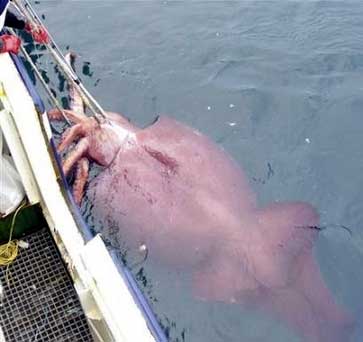Home > Ocean > Life in the Deep > Colossal Squid
Largest Invertebrate: The Colossal Squid
Mesonychoteuthis hamiltoni
Scientists have known about the existence of a species of squid that is reported to be significantly larger than the giant squid, but had not seen or collected a complete specimen of the Colossal squid, named Mesonychoteuthis hamiltoni. This species of squid was first identified in 1925 after two arms were recovered from a sperm whale's stomach. In 2003 a virtually intact specimen of this never-before-seen colossal squid had been brought up in Antarctic waters from an estimated depth of 2,000 to 2,200 meters. And recently, in February of 2007 a live colossal squid was brought to the surface in Antarctic waters by a New Zealand fishing boat. This time video was taken and the squid was captured for scientific study. This enormous squid, which was determined to be a male of the species, was 10 meters (32.8 feet), and weighed 1,089 pounds, making it the largest squid (the largest invertebrate) ever captured. What was even more astonishing is that, from what scientists know about squid species in general, there is great sexual dimorphism in squids, with females being significantly larger than the males. If that holds true for the Colossal squid, this male specimen that was captured could very well be dwarfed by a much larger female of the species.
 Colossal squid are known to inhabit the abyssal depths of the ocean primarily in the Southern Ocean that circumnavigates Antarctica. Evidence of their existence has been obtained from the stomachs of the largest predatory carnivore in the sea - the mighty sperm whale. Many Sperm whales carry scars on their backs believed to be caused by the hooks of Colossal Squid. One of the significant morphological differences between the giant squid and the colossal squid is the existence of swiveling hooks on each of the sucker discs in the clubs at the ends of the colossal squids' feeding tentacles. The giant squid merely have a circular, serrated row of 'teeth' inside each of their sucker discs. Either way, both of these species of squid make for formidable and terrifying predators of the deep. Colossal squid are known to inhabit the abyssal depths of the ocean primarily in the Southern Ocean that circumnavigates Antarctica. Evidence of their existence has been obtained from the stomachs of the largest predatory carnivore in the sea - the mighty sperm whale. Many Sperm whales carry scars on their backs believed to be caused by the hooks of Colossal Squid. One of the significant morphological differences between the giant squid and the colossal squid is the existence of swiveling hooks on each of the sucker discs in the clubs at the ends of the colossal squids' feeding tentacles. The giant squid merely have a circular, serrated row of 'teeth' inside each of their sucker discs. Either way, both of these species of squid make for formidable and terrifying predators of the deep.
Colossal Squid are a major prey item for Antarctic sperm whales feeding in the Southern Ocean; 14% of the squid beaks found in the stomachs of these sperm whales are those of the Colossal Squid, which indicates that Colossal Squid make up 77% of the prey consumed by these whales.
Not only are the Colossal squid the largest invertebrates in the world, they have the largest eyes of any living on earth - even bigger than the blue whale. Much of the evidence of these squids that has been gathered from the stomachs of sperm whales have been the enormous beaks of the colossal squid.
Here is an excellent page on the colossal squid, including close-up photos showing the wicked, lethal swiveling hooks of the colossal squid Giant Squid and Colossal Squid Fact Sheet
|
Get Your Degree!
Find schools and get information on the program that’s right for you.
Powered by Campus Explorer
|

